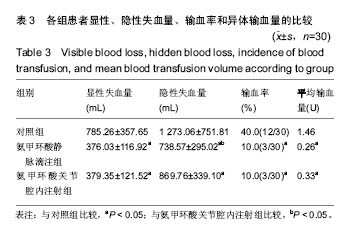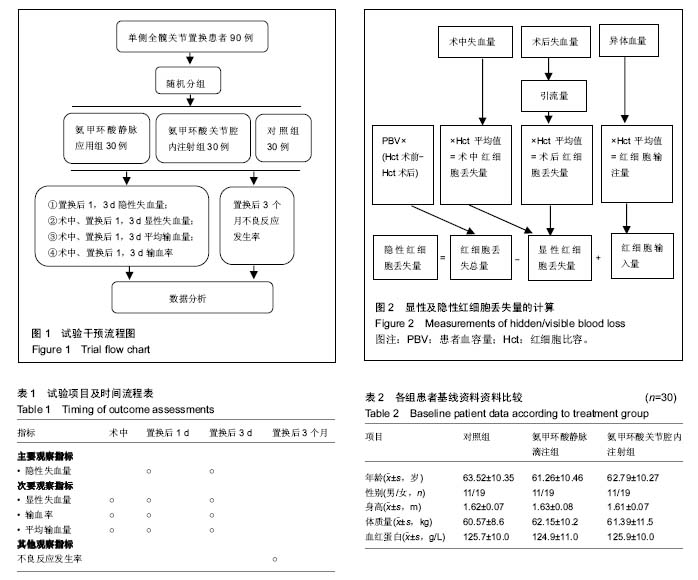| [1] Alshryda S, Mason J, Sarda P, et al. Topical (intra-articular) tranexamic acid reduces blood loss and transfusion rates following total hip replacement: a randomized controlled trial (TRANX-H). J Bone Joint Surg Am. 2013;95(21):1969-1974.[2] Bruce W, Campbell D, Daly D, et al. Practical recommendations for patient blood management and the reduction of perioperative transfusion in joint replacement surgery. ANZ J Surg. 2013;83(4):222-229.[3] Zhao J, Li J, Zheng W, et al. Low body mass index and blood loss in primary total hip arthroplasty: results from 236 consecutive ankylosing spondylitis patients. Biomed Res Int. 2014;2014:742393.[4] Gandhi R, Evans HM, Mahomed SR, et al. Tranexamic acid and the reduction of blood loss in total knee and hip arthroplasty: a meta-analysis. BMC Res Notes. 2013;6: 184.[5] McCormack PL. Tranexamic acid: a review of its use in the treatment of hyperfibrinolysis. Drugs. 2012;72:585-617.[6] Panteli M, Papakostidis C, Dahabreh Z, et al. Topical tranexamic acid in total knee replacement: a systematic review and meta-analysis. Knee. 2013;20:300-309.[7] Georgiadis AG, Muh SJ, Silverton CD, et al. A prospective double-blind placebo controlled trial of topical tranexamic acid in total knee arthroplasty. J Arthroplasty. 2013;28: 78-82.[8] Konig G, Hamlin BR, Waters JH. Topical tranexamic acid reduces blood loss and transfusion rates in total hip and total knee arthroplasty. J Arthroplasty. 2013;28:1473-1476.[9] Soni A, Saini R, Gulati A, Paul R, et al. Comparison between intravenous and intra-articular regimens of tranexamic acid in reducing blood loss during total knee arthroplasty. J Arthroplasty. 2014;29:1525-1527.[10] Patel JN, Spanyer JM, Smith LS, et al. Comparison of intravenous versus topical tranexamic acid in total knee arthroplasty: a prospective randomized study. J Arthroplasty. 2014;29:1528-1531.[11] Zhou XD, Tao LJ, Li J, et al. Do we really need tranexamic acid in total hip arthroplasty? A meta-analysis of nineteen randomized controlled trials. Arch Orthop Trauma Surg. 2013;133:1017-1027.[12] Aguilera X, Martinez-Zapata MJ, Bosch A, et al. Efficacy and safety of fibrin glue and tranexamic acid to prevent postoperative blood loss in total knee arthroplasty: a randomized controlled clinical trial. J Bone Joint Surg Am. 2013;95:2001-2007.[13] Cross J B. Esti mating allowable blood loss:corrected for dilution. Anesthesiology. 1983;58(3):277-280.[14] Panteli M, Papakostidis C, Dahabreh Z, et al. Topical tranexamic acid in total knee replacement: a systematic review and meta -analysis. Knee. 2013;20:300-309.[15] McConnell JS, Shewale S, Munro NA, et al. Reduction of bloodloss in primary hip arthroplasty with tranexamic acid or fibrin spray. A randomized controlled trial. Acta Orthop. 2011; 82:660-663.[16] 赵清斌,任姜栋,张晓岗,等.氨甲环酸静脉或局部及联合应用初次单侧全髋关节置换:围置换期出血及输血率的比较[J].中国组织工程研究,2016,20(4):459-464.[17] Martin JG, Cassatt KB, Kincaid-Cinnamon KA, et al. Topical administration of tranexamic Acid in primary total hip and total knee arthroplasty. J Arthroplasty. 2014;29:889-894.[18] Oremus K, Sostaric S, Trkulja V, et al. Influence of tranexamic acid on postoperative autologous blood retransfusion in primary total hip and knee arthroplasty; a randomized controlled trial. Transfusion. 2014;54:31-41.[19] Wong J, Abrishami A, El BH, et al. Topical application of tranexamic acid reduces postoperative blood loss in total knee arthroplasty: a randomized, controlled trial. J Bone Joint Surg Am. 2010;92:2503-2513.[20] Maniar RN, Kumar G, Singhi T, et al. Most effective regimen of tranexamic acid in knee arthroplasty: a prospective randomized controlled study in 240 patients. Clin Orthop Relat Res. 2012;470:2605-2612.[21] Gandhi R, Evans HM, Mahomed SR, et al. Tranexamic acid and the reduction of blood loss in total knee and hip arthroplasty: a meta-analysis. BMC Res Notes. 2013,6:184.[22] Lecker I, Wang DS, Kaneshwaran K, et al. High Concentrations of Tranexamic Acid Inhibit Ionotropic Glutamate Receptors. Anesthesiology. 2017. doi: 10.1097/ALN.0000000000001665. [23] Eachempati KK, Gurava Reddy AV, Apsingi S, et al. A comparative analysis of the role of Tranexamic acid as an independent variable in reducing intraoperative blood loss in patients undergoing conventional total knee arthroplasty versus computer-assisted total knee arthroplasty. Musculoskelet Surg. 2017. doi: 10.1007/s12306-017-0477-9.[24] Liu W, Yang C, Huang X, et al. Tranexamic acid reduces occult blood loss, blood transfusion, and improves recovery of knee function after total knee arthroplasty: a comparative study. J Knee Surg. 2017. doi: 10.1055/s-0037-1602248.[25] Hajmurad OS, Choxi AA, Zahid Z, et al. Aortoiliac thrombosis following tranexamic acid administration during urgent cesarean hysterectomy: a case report. A A Case Rep. 2017. doi: 10.1213/XAA.0000000000000535. [26] WOMAN Trial Collaborators. Effect of early tranexamic acid administration on mortality, hysterectomy, and other morbidities in women with post-partum haemorrhage (WOMAN): an international, randomised, double-blind, placebo-controlled trial. Lancet. 2017. doi: 10.1016/S0140-6736(17)30638-4.[27] Yuan X, Li B, Wang Q, et al. Comparison of 3 Routes of Administration of Tranexamic Acid on Primary Unilateral Total Knee Arthroplasty: A Prospective, Randomized, Controlled Study.J Arthroplasty. 2017. doi: 10.1016/j.arth.2017.03.059.[28] Wu Y, Yang T, Zeng Y, et al. Tranexamic acid reduces blood loss and transfusion requirements in primary simultaneous bilateral total knee arthroplasty: a meta-analysis of randomized controlled trials. Blood Coagul Fibrinolysis. 2017. doi: 10.1097/MBC.0000000000000637.[29] Fabresse N, Fall F, Etting I, Devillier P, et al. LC-MS/MS determination of tranexamic acid in human plasma after phospholipid clean-up. J Pharm Biomed Anal. 2017. doi: 10.1016/j.jpba.2017.04.024. [30] La Rochelle P. Prehospital transfer strategies and tranexamic acid during major trauma. Lancet. 2017. doi: 10.1016/S0140-6736(17)31012-7. [31] Ghavimi MA, Taheri Talesh K, et al. Efficacy of tranexamic acid on side effects of rhinoplasty: A randomized double-blind study. J Craniomaxillofac Surg. 2017. doi: 10.1016/j.jcms.2017.03.001. [32] Pabinger I, Fries D, Schöchl H, et al. Tranexamic acid for treatment and prophylaxis of bleeding and hyperfibrinolysis. Wien Klin Wochenschr. 2017. doi: 10.1007/s00508-017-1194-y. [33] Arantes GC, Pereira RMR, de Melo DB, et al. Effectiveness of tranexamic acid for reducing intraoperative bleeding in palatoplasties: a randomized clinical trial. J Craniomaxillofac Surg. 2017. doi: 10.1016/j.jcms.2016.12.021.[34] Xie JW, Yue C, Pei FX, et al. A retrospective study on the efficacy and safety of tranexamic acid for reducing perioperative bleeding during primary cementless total hip arthroplasty. Zhongguo Gu yu Guanjie Waike. 2014;7: 481-485.[35] Yue C, Kang P, Pei F, et al. Topical application of tranexamic acid in primary total hip arthroplasty: a randomized double-blind controlled trial. J Arthroplasty. 2014;29: 2452-2456.[36] Alshryda S, Sukeik M, Sarda P, et al. A systematic review and meta-analysis of the topical administration of tranexamic acid in total hip and knee replacement. Bone Joint J. 2014;96: 1005-1015.[37] Singh J, Ballal MS, Mitchell P, et al. Effects of tranexamic acid on blood loss during total hip arthroplasty. J Orthop Surg. 2010;18:282.[38] Kazemi SM, Mosaffa F, Eajazi A, et al. The effect of tranexamic acid on reducing blood loss in cementless total hip arthroplasty under epidural anesthesia. Orthopedics. 2010; 33:17.[39] Wu T, Zhang GQ. Minimally invasive treatment of proximal humerus fractures with locking com¬pression plate improves shoulder function in older patients: study protocol for a prospective randomized controlled trial. Clin Transl Orthop. 2016;1:51-57.[40] Yin PB, Long AH, Shen J, et al. Treatment of intertrochanteric femoral fracture with proximal femo¬ral medial sustainable intramedullary nails: study protocol for a randomized controlled trial. Clin Transl Orthop. 2016;1:44-50. |
.jpg) 文题释义:
文题释义:

.jpg) 文题释义:
文题释义: